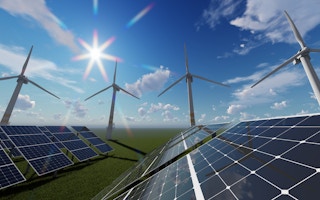The potential to tap clean energy every hour of the day could enable Asia Pacific (APAC) countries to achieve their net zero carbon ambitions.
While renewable energy solutions have been increasing across the region, resources have mainly gone towards wind and solar energy, which rely on ideal weather conditions. Solutions that can provide clean energy around the clock or balance out fluctuations, known as “firming” technologies, have yet to be fully harnessed.
One issue, according to a new report, is cost. Narrowing the cost gap of achieving “24/7 clean energy” – defined by the United Nations as meeting every kilowatt-hour of electricity consumption with carbon-free energy sources at every hour of the day – is highlighted in the latest report by AirTrunk, a technology company specialising in data centres.
The “Powering a Clean Energy Future” report looks at existing gaps in four APAC markets that prevent matching electricity demand with clean sources in a cost-optimal way. The paper outlines the need to achieve 24/7 clean energy and identifies the opportunities to bring down the cost of doing so for each market, with the actions required.
Referencing existing research, the report said that the push for 24/7 clean energy is more advanced in the European and North American markets today, due to greater market maturity in renewables. The report also found that while the cost of reaching 90 per cent 24/7 clean energy is already achievable at moderate cost premiums in those regions, the gap in the APAC markets studied is much wider.
‘Twin challenges’
Joscha Schmitz, head of energy and climate at AirTrunk, told Eco-Business that while there is interest in sourcing clean energy for large consumers in Asia, this has typically focused on matching renewable supply “on average,” referring to the average amount of renewable energy that can be generated over a certain period of time. “This is reflected in the products that energy providers currently offer to customers – often also because policy regulation limits what is possible,” he said.

Joscha Schmitz, head of energy and climate at AirTrunk, said Asia Pacific needs to look beyond securing intermittent and variable renewables. Image: AirTrunk
Referring to the issue of 24/7 clean energy in APAC as a “twin challenge,” Schmitz said the first challenge is increasing the availability of renewables in the region. The second challenge is ensuring that the correct technologies are utilised to enable a constant supply of clean energy.
“It has been fantastic to see the shift to power purchase agreements (PPAs) and other renewable buying options in many APAC markets in recent years,” he added. “But we do not just need clean energy – we also need stable energy and that includes clean firming and clean baseloads. That’s not yet fully explored in terms of how we collectively get there.”
While there is some progress is being made, especially in light of more APAC countries vying for private investment in the renewables sector, barriers remain especially in storing and dispatching energy in a flexible manner. Schmitz noted that energy grids in the region are largely isolated and not yet integrated, in contrast to the grids of Europe and the US, which are more interconnected.
“Most regional grids have different underlying resource potential and that means you need different technology solutions for each market. It also means that growing the interconnection between markets is a huge win; we have found that well-connected grids with average renewable potential outperform more isolated grids with great renewable potential,” explained Schmitz.
A recent report by tech company Google explores how corporate clean energy buyers can drive the development of advanced renewable technologies, and notes how “firm” carbon-free options such as nuclear power, bioenergy, and natural gas with carbon capture and storage, are able to offer a reliable energy supply throughout the year or for several months.
How the tech sector can drive clean energy
Leading the charge on a 24/7 carbon-free future is the tech sector, with global giants such as Google and Microsoft among the first to commit to ambitious hourly matching targets on their net zero journeys.
Numerous corporate signatories have also aligned with the UN 24/7 Carbon Free Energy Compact, adhering to its five key principles: time-matched procurement; local and regional procurement; technology inclusivity; enabling new generation; and maximising system impact.
Ivan Li, director, strategy and implementation, ENGIE Impact, a decarbonisation advisory firm, noted that substantial energy demand from large tech companies, coupled with their ambitious climate goals and a “buying power to match,” presents a unique opportunity for them to play a bigger role in supporting and investing in renewable energy resources.
He added that the tech sector can be a “driving force” in the clean energy transition by aligning energy consumption with environmental aspirations.
“This alignment is especially critical as it allows the tech sector to address one of the most significant pain points in decarbonising: tackling the cost-effectiveness of decarbonisation measures and bringing down the overall cost structure for 24/7 clean energy,” said Li.
Key to this trend is the rapid growth that hyperscale data centres have seen in recent years and data centre power consumption in the US market set to double within the next decade. The Asia Pacific and Japan region is projected to account for half of the global colocation market by 2026, according to AirTrunk’s report.
The increased dependence on cloud solutions and more recently, artificial intelligence, from customers also presents challenges, noted Damien Spillane, chief customer & innovation officer, AirTrunk, as these tools are powered by hyperscale data centres and require large amounts of electricity.
According to Yangyang (Nora) Li, a former UN energy specialist at Sustainable Energy for All, tech giants must therefore continue investing heavily in carbon-free energy sources.
“Major tech companies can also use their influence to advocate for policies that promote the transition to carbon-free energy,” she said. This, Li added, can include joining the UN 24/7 Carbon Free Energy Compact.
Sustainable hyperscale data centres
There have been increased investments in energy-efficient initiatives and renewable energy from data centres in recent years. Considering future growth, clean sourcing must be prioritised alongside the successful push for energy efficiency.
AirTrunk, for example, has implemented refrigerant-free and liquid cooling technologies in several of its facilities. Cloud service providers – many of which depend on data centres – are also prioritising renewable energy.
In 2022, a large portion of the 31.1 gigawatts (GW) of corporate PPAs signed were sourced by Amazon, Microsoft and Google.
The impact of this has been evident. Despite hyperscale data centres being used for cloud storage rising by 550 per cent between 2010 and 2018, energy use has only increased by 6 per cent, according to a 2020 paper by Science.
Many cloud service providers have also set 100 per cent renewable energy reliance targets; AirTrunk has committed to working with its customers to have 100 per cent of electricity consumed at its data centres matched with clean energy by 2030. Software company Oracle has also committed to powering its global operations with 100 per cent renewable energy by 2025.
Spillane agreed that the tech industry can accelerate the deployment of dispatchable carbon-free energy solutions, taking into account the sector’s scale and the 24/7 clean energy targets it has set.
“We are looking at how our data centre technology can assist with the energy transition and reinforce the grid,” Spillane said.
Moving forward, efforts must be made to drive 24/7 energy solutions in APAC markets. An early example came in November 2022, when AirTrunk launched a renewable energy solution in Hong Kong to match Microsoft’s data centre electricity consumption with local renewable energy certificates.
The solution directly links to the West New Territories Landfill Gas Power Generation Units of CLP Power and features hourly matching of renewable generation to data centre electricity consumption. This project exemplifies how innovative collaboration can play an important role in laying the foundation for a fully decarbonised grid across the region, while setting new standards for climate action.
With hyperscale data centres forecast to continue rapidly growing, it is crucial to identify ways to meet increasing power consumption needs for the digital economy – all while considering the climate agenda and targets within Asia Pacific and Japan.


















